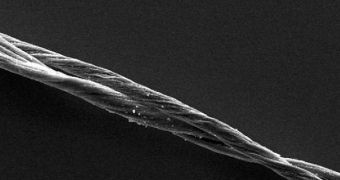A group of researchers at the Rice University has developed a new type of carbon nanotube-based wire that can be used to power line-voltage light bulbs. With this achievement, the goal of replicating electrical conductivities seen in metal wires via nanotubes gets inches closer to reality.
The team behind the study believes that their work will capture the eyes of numerous industries that currently use metal wires for transporting electricity. Their carbon-based counterparts provide a host of benefits and strengths that the metal-based transporters simply do not have.
In the future, energy systems may no longer be based on copper wires, but rather on double-walled carbon nanotubes (DWCNT). In their latest experiments, the Rice experts were able to power up a fluorescent light bulb using a standard line voltage by using their new wires.
According to the team, this was one of the most important tests to be passed, as well as one of the most critical tests for their device. Details of their accomplishments appear in this week's issue of Scientific Reports, a journal edited by Nature.
Rice professor of mechanical engineering and materials science Enrique Barrera, the leader of the study, says that highly conductive DWCNT wires could be developed to a point where they are just as efficient as their current competitors, but at only 1/6 the weight.
Due to this advantage, the new wires may gain a foothold in industries where weight is a factor, such as for example building airplanes and cars. When the system catches on, even standard electrical wirings in the home could be replaced by carbon nanotube-based systems.
One of the interesting aspects of the new cables is the fact that they can be tied together without losing their conductivity. The primary dopant (a chemical used to boost a desired property) the team used to increase conductivity was iodine. Even with this addition, the wires remained stable.
The specific conductivity (the ratio of conductivity to weigh) the DWCNT-based wires displays exceeds that of copper and silver, and is second only to sodium of all known chemicals. This is already a tremendous achievement for a field of research that is only in its infancy.
“We really want to go better than what copper or other metals can offer overall,” Barrera explains. The expert adds that the team's next goal will be to create thicker cables, while maintaining low weight.
Through systematic improvements, researchers could get to a point where they could bring the costs of such advanced materials low enough to make them competitive head-on with existing technologies.

 14 DAY TRIAL //
14 DAY TRIAL //